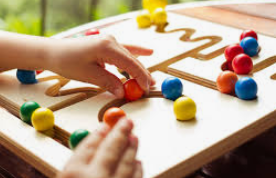Often when we occupational therapists introduce ourselves, a question mark appears above the heads of our interlocutors with the question: “What is that?”. Also, our profession is often confused with creative activities, which is far from the truth. In this text, we will explain what occupational therapy is, who occupational therapists are, how everyday activities are divided and what this means, and we will try to explain the way occupational therapists think while conducting various therapeutic activities with clients.
Occupational therapy is a health profession that aims to encourage and develop optimal (desirable) functioning in all daily activities, with both children and adults. It is often the misconception of public to think that occupational therapy is actually therapy with work, or job-finding. On the contrary, this type of therapy, through different models and approaches, gives us the opportunity to return to a state of optimal functioning, both in our work (at work) and in all other daily activities. Daily life activities include three areas, namely: self-care (hygiene, feeding, getting dressed) productivity (work or school obligations, playing skills for children) and free time (hobbies, socializing, sports).
Occupational therapy for children and adolescents is intended for those whose ability to function in daily activities is impaired for certain reasons, whether it is developmental impairment, congenital or genetic impairment, neurological impairment, physical injury, disease or specific emotional and social environment. Occupational therapists use different approaches and techniques in their work, which are based on theoretical assumptions (developmental group and integration group). They base their work on the assessment on this base they plan further intervention and goals of therapeutic treatment. The most commonly used approaches are: neurodevelopmental (NDN), sensory integration (SI), developmental, biomechanical, cognitive, learning specific skills and / or a combination of these approaches. In children, re / habilitation is more likely to be successful when is involving professionals of different sorts, and the family. The role of the family is well known, and is gaining a central role in occupational therapy. The philosophy of values and needs is different and unique for each family. Models in which the family and children define the priorities of the child’s functioning have proven to be more successful, and the therapist coordinates and applies specifically targeted activities to achieve this goal. Occupational therapy has a very wide application with the emphasis on early initiation / intervention, as early as possible.
The components that are evaluated and treated are:
Motor components (gross motor skills, fine motor skills, laterality, midline crossing, bilateral integration, occulo-motor coordination, oral-motor control)
Neuromuscular components (soft tissue integrity, reflexes, range of motion, muscle tone, strength, endurance, postural control, postural adjustment)
Cognitive components (categorization, sequencing, recognition, attention span, activity initiation, activity completion, learning, intelligence, generalization, problem solving, memory, spatial operations, concept creation)
Psychosocial components (use of time, values, self-conception, communication, self-control, role play, social behavior, interpersonal skills, self-expression)
Sensory components (tactile, auditory, gustatory, proprioceptive, olfactory, visual, vestibular)
Perceptual components (visual closure, stereognosis, kinesthesia, left-right discrimination, body scheme, object constancy, position in space, relationships in space, perception of depth, topographic orientation)
Children who can be referred to an occupational therapist are:
- Children with motor difficulties (eg. fine motor skills, gross motor skills, coordination, bilateral integration)
- Children with graphomotor skills problems
- Children with dysgraphia, dyslexia and dyscalculia
- Children with attention deficit problems and motor restlessness
- Children who have difficulty socializing
- Children with growth and developmental disabilities
- Children with ADHD
- Children with autism
- Children with Down syndrome and other syndromes
- Children with hemiparesis / hemiplegia
- Children with cerebral palsy
- Children with sensory integration difficulties, etc.
Occupational-occupational therapy encourages the development of the child’s functional abilities, which give him maximum independence, autonomy, in the activities of daily life, in different environments and with as few restrictions as possible. Early initiation of therapy and an interdisciplinary approach have proven to be the most successful treatment models.
By, Ana Drina, bcc.occup.therap.
